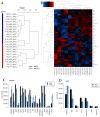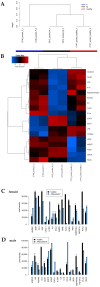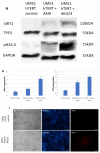Secreted Cytokines within the Urine of AKI Patients Modulate TP53 and SIRT1 Levels in a Human Podocyte Cell Model
- PMID: 37175937
- PMCID: PMC10179415
- DOI: 10.3390/ijms24098228
Secreted Cytokines within the Urine of AKI Patients Modulate TP53 and SIRT1 Levels in a Human Podocyte Cell Model
Abstract
Acute kidney injury (AKI) is a major kidney disease with a poor clinical outcome. It is a common complication, with an incidence of 10-15% of patients admitted to hospital. This rate even increases for patients who are admitted to the intensive care unit, with an incidence of >50%. AKI is characterized by a rapid increase in serum creatinine, decrease in urine output, or both. The associated symptoms include feeling sick or being sick, diarrhoea, dehydration, decreased urine output (although occasionally the urine output remains normal), fluid retention causing swelling in the legs or ankles, shortness of breath, fatigue and nausea. However, sometimes acute kidney injury causes no signs or symptoms and is detected by lab tests. Therefore, the identification of cytokines for the early detection and diagnosis of AKI is highly desirable, as their application might enable the prevention of the progression from AKI to chronic kidney disease (CKD). In this study, we analysed the secretome of the urine of an AKI patient cohort by employing a kidney-biomarker cytokine assay. Based on these results, we suggest ADIPOQ, EGF and SERPIN3A as potential cytokines that might be able to detect AKI as early as 24 h post-surgery. For the later stages, as common cytokines for the detection of AKI in both male and female patients, we suggest VEGF, SERPIN3A, TNFSF12, ANPEP, CXCL1, REN, CLU and PLAU. These cytokines in combination might present a robust strategy for identifying the development of AKI as early as 24 h or 72 h post-surgery. Furthermore, we evaluated the effect of patient and healthy urine on human podocyte cells. We conclude that cytokines abundant in the urine of AKI patients trigger processes that are needed to repair the damaged nephron and activate TP53 and SIRT1 to maintain the balance between proliferation, angiogenesis, and cell cycle arrest.
Keywords: SIRT1; TP53; acute kidney injury; cytokines.
Conflict of interest statement
The authors declare no conflict of interest.
Figures




References
-
- Hoste E.A.J., Bagshaw S.M., Bellomo R., Cely C.M., Colman R., Cruz D.N., Edipidis K., Forni L.G., Gomersall C.D., Govil D., et al. Epidemiology of acute kidney injury in critically ill patients: The multinational AKI-EPI study. Intensive Care Med. 2015;41:1411–1423. doi: 10.1007/s00134-015-3934-7. - DOI - PubMed
MeSH terms
Substances
LinkOut - more resources
Full Text Sources
Research Materials
Miscellaneous

